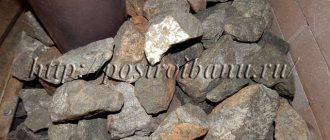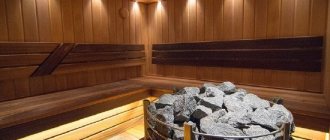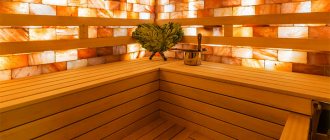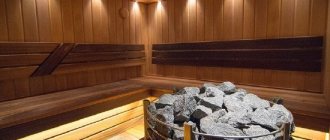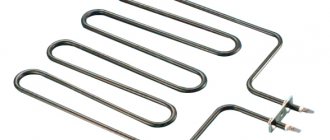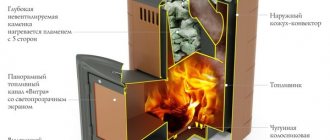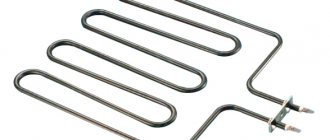The traditional way to heat a Russian bath is a heater stove. It occupies a central place in the room and provides the necessary heating, steam formation, and creates a specific microclimate and aroma in the bathhouse. At the same time, the term “heater stove” itself denotes a huge group of varieties and models.
In practice, it combines all types of sauna stoves equipped with a special design element. Such stoves are found in private and public baths; they are an obligatory element of the steam room, its integral part. Let's take a closer look at this issue.
5/5 — (1 vote)
Closed and open sauna stoves
The key difference between closed and open heaters is the design of the container used to hold the stones. In the first case, the stove is equipped with a closed casing with a door that allows you to apply water to the hot stones to produce steam. For open models, a casing made of sheet metal or metal mesh provides constant access to the top of the stone backfill or to the entire massif. This makes it possible to get rich steam without any hassle.
Closed heaters for Russian baths
In a traditional Russian steam room, the air temperature is maintained at a level not exceeding 70-80°C, while the humidity level should be at least 65%. Steam, saturated with moisture, makes the heat comfortable and has a healing effect on the body - the pores open, and toxins come out with sweat.
Heaters of a closed design allow you to regulate the level of temperature and humidity. The stone backfill heats up to 350-750°C, but the closed casing retains heat from the stones and the room warms up to the required level.
The advantages of heaters of a closed design include:
Slower, but more uniform heating of the steam room, which makes the conditions for bath procedures more comfortable.
Strong heating of the stone backfill - it accumulates heat and does not allow the bath to cool for a long time, which makes it possible to spend less fuel without compromising the duration of the bath procedures, and to steam without reheating.
There is no overheating of the air, the temperature in the room is kept at a level that is comfortable for humans.
Containing steam inside the casing, where it infuses, resulting in a rich and light vapor.
Possibility to increase the speed of heating the air in the steam room by slightly opening the heater door.
Fireproof design.
The thermal characteristics of a closed heater depend on the material from which it is made. A steel stove heats up and cools down faster than a cast iron stove, which retains heat longer, but also spends significantly more time warming up the room.
Open heaters for steam rooms
Open-type heaters successfully compete with stoves equipped with a closed casing. The design, in which the stone backfill remains fully or partially open, helps to quickly warm up the room, but the cooling process also takes less time compared to using a closed heater.
It is important to consider that a stove with an open casing intensely releases heat and allows the air in the steam room to be heated to very high values. This will be appreciated by fans of the Finnish sauna, which is characterized by heating up to 90°C with a humidity of 15%. If such a heater is used for a Russian bath, it is necessary to monitor the temperature and very carefully add water to avoid health risks.
There are different types of open heaters:
Ventilated - with holes in the metal casing, due to which heat is released faster.
Non-ventilated - without holes, they warm up the steam room longer and accumulate heat better.
Open heaters have to be heated all the time - the wood quickly burns out and fuel consumption is noticeably increased compared to a closed type stove.
Combined option
If a closed stove is the choice of lovers of a Russian steam room with moderate heat and humid air, then an open heater is suitable for those who prefer dry heat. There are also combined models. Thanks to the closed casing, they retain heat well and consume fuel economically, and the open casing with stone backing gives an attractive appearance and speeds up the heating of the steam room.
Manufacturers of metal units for baths
If the question arises, what are the best stoves for a sauna with a closed heater, then it is worth talking about the most popular and proven products. They are present in the lines of the following manufacturers: Vulcan, Teplodar, Termofor (read: “How to choose and install a Vulcan stove for a sauna”). There are also devices with a closed heater from Finnish companies.
The following enterprises produce metal stoves for Russian baths:
- Fehringer;
- Kutkin;
- Teklar;
- Troika;
- Kalita;
- Svarozhich;
- Enchantress;
- Isistim;
- Sudarushka.
Manufacturers who are in the top four have already earned a positive reputation - customers speak of them as reliable manufacturers.
As for the other companies, their products can be divided into two types: metal products and cast iron with a closed heater. Cast iron appliances are produced under the following brands: Kalita, Sudarushka and Svarozhich. But it is worth noting that in products of the Sudarushka brand, only the firebox is cast from cast iron, and the water tank and container for stones are made of steel. But since the basis of the stove is the firebox, this model can also be classified as cast iron products.
Main selection criteria
To decide which heater to choose for a bath, first of all take into account:
- how often the sauna will be used.
- priority of steam room heating speed or steam quality.
- type of available fuel.
When it is important to be able to quickly prepare the steam room for bathing procedures, choose an open-type heater. When priority is given to steam quality, a closed furnace is installed.
If the house is connected to the gas network, it makes sense to pay attention to a gas heater. The steady demand for electric models of sauna stoves is explained by ease of use, but electricity is the most expensive energy carrier and this option is usually chosen by people who do not plan to regularly and intensively use the sauna. Wood-burning heaters are most in demand due to the availability of fuel. A wood stove made of heat-resistant steel or cast iron is suitable for intensive use.
Wood-burning sauna stove: what to choose based on?
There are several criteria that instantly eliminate many ovens.
Power
Firstly, you need to correctly calculate the power of the stove, do not take one that is smaller or right next to each other, because working at the limit usually greatly shortens the life of the device - the iron burns out faster.
You should not take a stove with a large power reserve, because when using a small percentage of the rated power, the efficiency is usually greatly reduced.
IMPORTANT! We recommend choosing a stove a couple of kilowatts more powerful than what is needed according to calculations.
The calculation is relatively simple: the main figure is the volume of your steam room, and then numbers with increasing factors are added to it.
This happens if the door to the steam room is made entirely of glass (add one and a half cubes to the volume), if there are surfaces without thermal insulation - tiles, glass, etc. (we measure their area, multiply by 1.2 and add to the volume), and also if the bathhouse is a log house without any thermal insulation at all (we immediately multiply the volume by 2).
You should also consider whether the stove will heat adjacent rooms or whether another heat source will be located there.
In winter and summer, the heating time for the steam room will be different. And since stove manufacturers usually indicate the minimum and maximum volumes for which the stove is designed, in winter you should focus on the first number.
Preferred sauna type
If the owner is a fan of the Finnish sauna, then his choice is practically unlimited: all models of metal stoves are suitable for him. He doesn't need a brick oven at all. And an electric stove can be a good alternative to a wood-burning heater - provided that you don’t mind burning electricity.
It’s more difficult for fans of the Russian bathhouse. The best option for them is still a brick stove, but a compromise can be reached if you line a high-quality metal stove, for example, made of cast iron, with brick.
Stoves with mesh heaters, open heaters, or with a body that is not lined with brick or stone are not suitable for a Russian bath.
As mentioned above, a closed heater is required in the stove for a Russian bath.
An electric stove is suitable for a Russian bath only if it is a “thermos”, that is, a closed electric heater. Or if the electric heater has a steam generator and the range of temperatures achieved varies widely. (Because you can't do high temperature and high humidity at the same time).
What remains are those who like to steam, who like to alternate modes to suit their mood. In this case, the stove must again have a closed heater, but it can be combined with an open one. Electric furnaces with different modes are also suitable.
Durability
By the way, this is not such an unimportant factor. Many people would like, if they invest in a stove, to have it last for a long time.
Brick and cast iron stoves will be durable (with proper operation). In the latter case, as already mentioned, it is necessary to clarify not only the thickness, but also the grade of cast iron.
Steel stoves made of stainless steel with a high (17%) chromium content will be durable and expensive. Buyers who prefer inexpensive solutions also have the opportunity to make the best choice.
ON A NOTE! The service life is shortened not only by working at the limit, but also by installing a gas burner in a wood-burning stove - the temperature of the flame increases twice, if not more, and the metal is not designed for this. It is especially bad if the gas flame touches the walls and upper ceiling of the stove.
Features of a wood-burning heater
Wood-burning heaters consist of two compartments - a firebox and a casing for stones located in the upper part, open or closed. When choosing a model, you should pay attention to the size of the firebox and the maximum length of the log; this affects the ease of use of the stove.
The heat generated during the combustion of wood is transferred to the stone backfill and the metal casing. The air is heated by thermal radiation and convection.
What is the main thing about bath stones?
The stones in the bathhouse are subject to serious stress. The furnace heats them up to hundreds of degrees, after which the stones are sharply cooled by water, which is poured onto them to produce steam. Then the stones heat up again, cool down sharply again, and so on dozens of times in just one vaping session. Therefore, cobblestones picked up near the house are not suitable for placing in a kiln - they will quickly turn into dust and, well, if they do not fly into fragments, injuring others. And some breeds are downright dangerous in a small steam room. For example, the familiar granite can be radioactive, and a beautiful red pebble picked up near a nearby river can turn out to be poisonous cinnabar, which releases mercury vapor and sulfur when heated.
Unlike ordinary ones, the stone types selected for sauna stoves are:
- Safe . They do not splinter and are non-toxic when heated.
- Durable . Resistance to high temperatures combined with a homogeneous structure allows the stones to maintain their integrity and shape for a long time.
- Keeps warm well . The stones not only produce steam, but also, due to their high heat capacity, act as a heat accumulator, maintaining heat in the steam room even after the fire in the stove goes out.
These properties are common to all types of bath stones. Different breeds differ from each other only in how well these properties are manifested in them. And, of course, appearance.
Types of heater stoves
When choosing a closed or open type heater model, you should pay attention to a number of parameters, including:
- heating unit performance;
- material of manufacture;
- design features;
- design.
Performance
The power of the heater must correspond to the volume of the steam room. If you install a stove with insufficient performance, it will be impossible to warm the room to optimal temperatures. Using an overly powerful unit is not advisable - such a heater is more expensive, takes longer to heat up, consumes more fuel, and can overheat the room, which is unsafe for health. When choosing, you should rely on information from the heater manufacturer - for each model the maximum volume of the steam room in cubic meters is indicated. It is worth noting that the weight of the loaded stones also depends on the volume of the steam room - the higher this indicator, the more heat the stone backfill can accumulate.
Material of manufacture
Factory-made heaters are made of metal. It could be:
- cast iron;
- structural steel;
- heat-resistant steel;
- stainless steel;
- heat-resistant stainless steel.
The durability and cost of the stove depend on the material. Models made of carbon structural steel are affordable, but burn out faster. When choosing such a stove, you should pay attention to the thickness of the metal - it is better if it is at least 6 mm.
Heaters made of stainless steel, heat-resistant or heat-resistant metal are more reliable and durable. Cast iron has the longest service life. But brittle cast iron is sensitive to mechanical stress and sudden temperature changes - it is important that the hot metal does not come into contact with cold water.
A steel heater will quickly heat the steam room, but to maintain the operating temperature it is necessary to constantly add fuel. A cast iron stove requires less maintenance because the thick cast iron functions as a heat accumulator.
Variety of EasySteam stoves
This company presents five lines on the market. Four of them are for baths of various sizes: Sochi, Yalta, Gelendzhik, Anapa. “Cherepovets Blast Furnace” is offered for professional service. A special feature of EasySteam products with a closed heater is the side door, designed for convenient maintenance of the heating unit. It may be on the left or right, so this point needs to be discussed when ordering.
Furnaces are produced either protected by a brick screen, or lined with slabs of coil or soapstone. Technical parameters differ for different models. Those that have lining are characterized by large size and weight, as well as a significant price. The weight of the facing material can reach 250 kilograms.
Such a closed heater for a bath, such as “Sochi”, “Gelendzhik” and “Anapa” has the same device inside. They differ in power, and accordingly, are suitable for steam rooms of various sizes. Modifications in the same line have differences in the size of the compartment for stones, and based on this, the thermal inertness of the furnace.
The greater the number of stones, the longer the steam room warms up, but at the same time it allows you to get a larger amount of steam. Its inertia is also ideal for drying the steam room, since the stones release the resulting heat for a long time.
A new product among the EasyStream line, “Yalta” has a different design, which is a kind of mesh oven. But it is quite unconventional: a closed internal heater is located around a chimney, which is surrounded by an open and ventilated heater.
This design makes it possible to shield radiation without creating a massive screen or expensive cladding, and at the same time obtain light and good steam. Therefore, EasySteam stoves from the Yalta line are well suited for Russian baths.
Consumer reviews about EasyStim stoves:
- When I first went to the steam room, there was a brick sauna stove with a closed heater. Then I decided to build a home sauna and chose the EasyStream stove. The steam is excellent, two loads of solid fuel are enough. The steam gun is great. The downside is that the adjustment knobs are hot. I maintain the temperature at about 55 degrees.
- I installed an Anapa stove with brick lining in the bathhouse. In summer, the temperature becomes necessary in about an hour and a half, in winter – after three hours. The bathhouse measures 30 square meters. When the device warms up, heating of water in a tank with a volume of 100 liters begins.
- I really like the EasySteam Sochi model. The laying of stones is large, but you can create different types of steam rooms. By opening and closing the dampers, it is possible to obtain either dry and hot steam, or moist and cool steam. And since my bathhouse is commercial, I can please different clients.
Design features and functionality
The variety of models (TMF, Grill'D, Vesuvius, etc.) of sauna stoves complicates the choice of a suitable heater. Let's consider the main structural elements that affect the functionality of the heating unit.
Combustion tunnel
Combustion tunnel of a sauna stove:
- ensures the flow of oxygen into the firebox from adjacent rooms, making it easy to breathe in the steam room;
- eliminates the steam room from debris and dirt accompanying fuel loading;
- makes it possible to admire the flame through the viewing window.
Convector
Special holes in the upper part of the steel casing of the heater promote intensive movement of air masses in the room, due to which the steam room warms up quickly and evenly. The “cold below, hot above” effect is eliminated, which adds comfort.
Water heating tank
A tank built into the stove or connected to the chimney allows:
- maintain air humidity in the steam room at a comfortable level;
- always have a supply of heated water for a warm shower;
- increase the efficiency of the heating unit.
Built-in heat exchanger
The heat exchanger built into the sauna stove makes it possible to use the thermal energy of the stove to heat water for showering in a hanging storage tank. The heat exchanger can also be used to heat a shower room or rest room by installing a circuit with forced circulation.
Chimney location
Heaters are offered with a central location of the chimney outlet and with an offset one relative to the center. In the second case, access to the stone backfill is more convenient; in addition, due to the displacement of the chimney, the smoke path increases and the heat transfer of the stove increases.
Door design
Heater stoves are equipped with firebox doors in different designs:
- deaf;
- with heat-resistant glass insert;
- with a large translucent heat-resistant screen.
The design of the door significantly affects the design and cost of the sauna stove.
Features of choosing a gas oven
To install it, you need to obtain special permission. A good model is quite expensive, so this type is relatively rarely preferred today. And in vain, because in the long run it pays for itself many times over.
Advantages and design features
The body is equipped with a gas burner, above it there is a pipe for removing combustion products and a tray with stones. Usually there is a thermostat and a fuse that stops the fuel supply when the flame disappears; an additional water heating tank can be added (or even included in the kit).
The gas model has the following advantages:
- the temperature is adjusted automatically;
- the steam room heats up evenly and in a short time;
- there is no need to periodically load fuel - it is supplied without your participation as it is consumed;
- Maintenance is as simple as possible - in particular, there is no need to empty the ash pan.
And this is with constant gas availability and comparative safety of the design.
Installation requirements for gas models
- Such equipment must be placed on a flat and solid base, separated from the foundation - for stability.
- The walls must be protected from thermal effects by separating the heating unit with insulating material (graphite fiber or asbestos).
- If gas will be taken from a common line, it should be connected to it using a reliable hose. If from a cylinder, then it is important to protect it from temperature influences, for example, place it outside the steam room.
- It is also necessary to organize ventilation, place additional devices and accessories (such as a water tank) and integrate a control system.
Requirements for a modern heater
A high-quality sauna stove meets a number of requirements:
- made of materials designed to withstand intense thermal loads over several years of operation;
- safe to use, the risks of fire, carbon monoxide poisoning, etc. are minimized;
- a balance is maintained between the heating rate and cooling intensity, ensuring a comfortable level of humidity;
- uses fuel economically;
- as compact as possible without sacrificing performance;
- convenient to use.
Types of closed heaters for baths
Stoves with internal heaters come in two varieties: intermittent and continuous.
In the first case, the stones lie above the firebox on a grate of one kind or another, which allows the flames and fuel gases to freely penetrate through their pile. The contact is complete, which ensures maximum heat transfer.
Russian sauna stove with closed heater
The grate can be the brick arch of the firebox or metal, for example, cuttings of rails. But it still depends on what material the stove is made of and what design it is. But here's what's important:
Important! A batch stove does not allow water to be poured onto the stones during the firing process. You need to wait until the fuel burns out, and only then splash. Otherwise you would have doused the fire.
If you place the stones in a metal box , then direct contact with the flame is lost, and you get a dull heater in which the fire heats the metal, and the metal heats the stones. Heat transfer is less perfect, but at the same time the stove can be heated all the time (it becomes permanent ), soot does not enter the room at all (this is the same “ white ” stove), in general, all the disadvantages have their advantages.
Individual choice
Requests for stove equipment for a steam room vary markedly - from family use to professional use.
For a Russian bath, the ideal option would be a closed heater with the ability to close and open the vents to regulate heating and humidity. The unit provides “light” steam and a soft microclimate due to the predominance of thermal radiation over convection.
A Finnish sauna or dry-air steam room requires the installation of a steel stove with convection holes, which will quickly heat the room to 90 degrees. Stone backfill in a casing or mesh helps reduce the heat. The larger the stone mass, the longer the stove retains heat and creates a softer microclimate.
When choosing a model, consider:
Thermal power of the heater - in summer, all rooms of the bath should warm up in 40 minutes, in winter - in 1.5-2 hours.
Duration of operation - at least 3-4 hours of continuous operation with good heat retention.
Quality of workmanship – cast iron, stainless heat-resistant steel, carbon steel with a thickness of at least 6 mm are recommended.
The presence of a heat exchanger to increase efficiency and reduce fuel consumption.
Making a homemade metal stove
A do-it-yourself bathhouse stove made of iron is made in accordance with standard drawings, which can be quite easily found on the Internet. First, you will need to select the material and tools necessary for the work. In this case, you will perform almost all operations on assembling the stove using a welding machine and an angle grinder.
As for the material, you will need a metal sheet, preferably chrome-plated, with a thickness of at least 5 mm. He'll go to the ash pit. You can use such a sheet and at the same time a metal corner, 3-5 mm thick, on the stove frame.
To make the firebox and the bottom of the water tank, you will have to prepare thicker material - 7-10 mm. You will also need metal pipes of different diameters for arranging the chimney and stove piping system.
But the doors for the firebox will need to be purchased ready-made at a construction and household goods store. It is best if they are made of cast iron, but if necessary, you can weld them yourself from the remains of a thick-walled pipeline.
You can also buy a mesh for stones, but in any case, fittings and shut-off valves, as well as grate bars, will have to be purchased, since it will not be possible to make these elements yourself. They are inexpensive, so you can buy them quite easily.
After the material has been prepared, you can begin assembling the furnace. To do this, take a drawing and, based on it, begin to cut out blanks using an angle grinder and weld them together
In this case, special attention should be paid to the assembly of the chimney and firebox as the most critical areas of the entire structure
Separately, it is worth noting the fact that when the question arises of how to make a stove for a bathhouse with your own hands, people always wonder whether the metal structure needs to be covered with bricks? This decision is opposed by the possible excessive consumption of fuel, because the furnace, in addition to metal, will also have to heat the brick. However, everything can be compensated by the beautiful appearance of your steam room and the unique microclimate created in the room by the heated brick.
Workmanship
When buying a steel heater for a bath, you should also pay attention to:
The quality of welds - this indicates the strength and reliability of the structure;
On the shape of the bottom of the combustion chamber - if there are bevels, this means that the walls will not burn out from the coal remaining after burning wood;
For fastening a glass door - if there is a frame around the perimeter of the glass, cracking is practically excluded.
Themselves with a mustache
My wife and I built a dacha back in the 80s. There is no need to explain how things were with building materials then. Therefore, the structure of the house is frame: beams, covered on the outside with clapboard, and on the inside - with whatever God sent. The dacha was built in stages. First, they built a small (3x4 m) main building, then a veranda, and on the opposite side they built a so-called rose garden, i.e. glazed extension without a floor.
The most common materials available at that time were used as insulation inside the walls: scraps of padding polyester, foam rubber, and even old tights.
EVERYTHING YOU NEED FOR THIS ARTICLE IS HERE >>>
Heating was carried out using a classic potbelly stove. The stove was reliable, cast iron, double-walled (filled with granite chips) and had a special welded stainless steel head.
Russian steam room with open heater
Heating stones in a closed furnace to 350-700°C allows one to obtain steam with a finely dispersed structure and a relatively low moisture content. This steam does not burn and does not change blood pressure.
If you heat the backfill in an open heater to high temperatures, the air will quickly overheat, and the water that gets on the stones will create heavy, moist steam that is dangerous to the body. If an open type stove is installed in the steam room, then a special device - a steam generator - will help to obtain dry steam. The steam gun is located on the side of the heater and takes up minimal space.
Steam gun
The operation of a closed heater depends on how isolated it is from the walls of the unit and the state of the air in the steam room. The better these indicators are, the hotter the stones will be able to heat up. However, in this case there is a problem with how to supply water to the stones.
In order to obtain steam inside the heater, a system of tubes with holes is installed. A glass or funnel is attached to the outside and water is poured in. It flows down the tube down the unit. Such a device is called a heat gun. It got its name because the escaping steam makes loud sounds, reminiscent of a gunshot.
When using this device, it is recommended not to limit yourself to a single tube - it is better to make a branched version at the bottom, which will evenly distribute the liquid throughout the stove and bring it to the hottest zones.
Good light steam is finely dispersed steam that is formed in a split second. You can only get it from very hot stones. If you splash water on stones that are not hot enough, the moisture from them will evaporate slowly, and a damp fog will hang in the steam room, difficult for a person’s lungs to tolerate.
Since the stones at the bottom of the pile, in contact with the combustion chamber, are the hottest, this is where I would like to splash some water, but how? By installing a steam gun or steam generator.
Its designs may be different, but the essence is the same - it is a pipe, the upper part of which rises above the stove, and the bottom goes deep into the stone pile. At the end there may be branches and holes through which water is supplied.
Steam generator for a bath
The device received the name “gun” for its muzzle-shaped shape and the clap, like a shot, with which steam escapes.
Many manufacturers produce guns of a certain model that fit their boilers. But you can make a device from scrap materials with your own hands.
The best models of generation guns go down to the very bottom of the pile and have a valve at the top that will prevent the steam, while still heavy, from escaping through the top of the pipe. Moisture should rush down to the bottom of the heater and, passing through the holes, wash the stones, and only then enter the room.
If you apply water with the addition of sea salt to hot stones, the steam will be hotter and will also have a disinfecting effect. It is best to feed boiling water into a steam cannon.
Buying a heater: the low price trap
You shouldn’t skimp on a sauna stove. A low price tag for a heater usually means that:
- low quality metal used;
- the thickness of the walls of the firebox and body is minimal;
- the equipment is meager;
- manufacturing technology is outdated.
But an excessively high price does not always indicate impeccable quality. The price tag is inflated due to the popularity of the brand or advertising costs when promoting a new product to the market.
How to stay safe
Standard fire safety rules require that a pre-furnace sheet at least half a meter in length be placed in front of the firebox, and that the distance from the firebox to the nearest wall be at least one and a half meters.
Brick stove for a Russian bath. There should be a pre-furnace sheet in front of the firebox (marked with an arrow)
Left in the photo: pre-furnace sheets in the store
A brick sauna stove should not be connected to the wall. A gap should be left between them. It is needed primarily due to the thermal expansion of the furnace - with a rigid connection, cracks may appear. And so its surface does not heat up to the combustion temperature of wood.
However, a brick sauna stove is still a fire hazard. It's all about cracks that appear over time both in the stove itself and in the chimney, and can cause sparks to be released. The only way to fight is prevention. The crumbling seams are cleaned and sealed with new mortar.
Why are stones used?
The stone backfill serves as a heat accumulator and steam generator. The stones accumulate and release heat for a long time, preventing the steam room from cooling down, maintaining the working temperature in the room. When water comes into contact with hot stones, steam is generated - this makes it easy to regulate the air humidity in the steam room.
Depending on the stove model, the stones are placed inside the firebox, in a special box closed on three sides, or in a lattice basket. The volume of backfill is determined by the design of the heater and the area of the room - it may require from a couple of tens to a hundred or more kilograms of stones.
Stove location
The heating device is placed in the bathhouse in such a way that the structure can heat all rooms of the building. Usually the front wall of the heater with the combustion door and ash pan is located in the dressing room.
The choice of a finished device or the calculation of a stove for a bath during design is carried out taking into account the area of the steam room. If no more than 2 m2 is required to place a heating device, it is often installed in a specially created niche.
Heater stove in a specially prepared niche Source sdelaikamin.ru
This arrangement makes it possible not to expose the front wall of the device with the combustion door and ash pan to the dressing room. In this case, the stove will have to be heated from the steam room. This option is used when it is necessary to reduce heat losses and there is no need to heat other rooms in the bathhouse.
How to choose the right stones?
The characteristics of the rock affect the safety of using the heater, the ability of the backfill to store heat, and the quality of steam. When choosing stones, pay attention to the following parameters:
- harmlessness;
- resistance to heat and temperature changes;
- heat storage properties;
- dimensions.
To fill the heater, you cannot use minerals with increased radioactivity and emitting harmful substances. Rocks with low heat resistance are also dangerous - with strong heating and sudden uneven cooling, they crack, including breaking into fragments.
Heat storage properties depend on the density and homogeneity of the rock structure. The higher these indicators, the faster the stone mass warms up and the longer it cools. Such stones successfully withstand sudden temperature changes when water is splashed onto a hot backfill to add steam.
The dimensions of stones for a sauna stove generally vary from 5 to 15 cm. For electric heaters, the ideal option would be a backfill of stones up to 7 cm. It is better to form the stone mass of a wood-burning stove from stones of different sizes. The largest ones are placed in the water supply zone - due to their mass, they cool less when they produce steam, and this allows the backfill to release heat longer after the fuel burns out. Medium and small stones are used to fill the remaining space, increasing the density of the backfill - its heat-accumulating properties depend on this. Stones of the coarse fraction should make up 40-50% of the backfill, medium stones - at least 25%, and the remaining 15-20% belong to the small fraction.
Brick stove foundation
In order to safely use a heating brick structure in a bathhouse for a long time, a foundation for the stove is always created first. It must be carried out in the form of a separate structure if the weight of the heater is more than 700 kg. In this case, the distance between the foundation of the bathhouse and the stove should be at least 0.5 m.
To avoid mistakes, it is better to entrust the construction to a master from a specialized company. Typically, specialists perform work in the following sequence:
- Dig a pit with a depth below the freezing point of the soil, but not less than 50-70 cm.
When determining the width and length of the pit, the size of the sauna stove is taken into account. The pit around the perimeter is 10-15 cm wider than the heater. The increased size of the pit allows for free installation of the formwork.
Pit for the foundation of the stove Source sdelaikamin.ru
- Pour sand into the bottom of the hole.
The sand cushion is watered to compact the layer. Then sand is added so that its thickness at the bottom of the pit is 15 cm.
- Pour broken bricks onto a compacted sand layer. Stones are also used.
The second layer is also compacted. To eliminate the free space between the stones, sand is used, which is compacted with water. Typically the thickness of the 2nd compacted layer is 25 cm.
- Fill in crushed stone and compact the third layer.
- Install the formwork.
4 cm thick boards are used for the box. When determining its internal dimensions, the width and length of the furnace foundation are taken into account. The upper edge of the wooden box is placed at the level of the subfloor of the bathhouse. The formwork is securely fixed in the pit.
- Install the reinforcement frame inside the box.
The distance between it and the formwork walls is usually 5 cm.
- Concreting is carried out.
The poured solution is compacted using steel reinforcement. A wooden block is rarely used. The concrete surface that has not yet hardened is leveled along the edge of the formwork.
Poured and leveled foundation Source fishki.net
After the solution has cured, the formwork is removed. The concrete surface is covered with tar in two layers. Then the free space between the concreted area and the walls of the pit is filled with gravel or sand. Then the foundation for the sauna stove is covered with polyethylene. It is left in this state for a week.
Calculation of stove power for a bath
Average value: 1 kW = 1 cubic meter. The technique is as follows:
- Calculate the volume of the steam room. If the room is 3x2 m, the ceiling height is 2.3 m, then the figure is 13.8 cubic meters.
- Calculate the area of window and door openings, multiply the resulting figure by 1.2 to calculate heat loss. Sum up the areas. If the window is 0.4 sq.m. and the door is 1.8 sq.m., then the total area is 2.2 sq.m.
- Find out the volume. Taking into account the indicated values - 2.2x1.2 = 2.64 cubic meters.
- Add up the indicators. Result - 16.44 cubic meters.
If the bathhouse is unfinished and the thermal insulation is low, then the resulting figure should be multiplied by 1.6 (16.44x1.6 = 26.3). The desired value is 26-30 kW (if taken with a small margin).
As standard for factory units, the power is specified in the accompanying documentation. If it is missing, then the area of the space is taken into account for the calculation. The volume of the firebox is calculated and multiplied by 0.5.
Features of room heating
There are hot and cold ovens, taking into account the degree of heating of the walls. The room will quickly become warm if the surface of the heater heats up to +100°C. This is a good option when the bathhouse is not equipped with constant heating. Although it is difficult to monitor the temperature in the steam room. The air may overheat or remain cold.
A hot stove is suitable for a private steam room because it transfers heat well through the outer walls. But you can get burned and it is difficult to regulate the heating temperature.
The walls of a cold oven heat up to +40…+45°C (no more). Cold air enters through special channels and returns in a heated form. Such stoves are safe and convenient. They are distinguished by a stable thermal regime. Although the steam room takes a long time to warm up. This option is not suitable for quickly heating up the stove and visiting the bathhouse.
Top 1. TMF Urengoy
Rating (2021): 4.75
The most popular heater A product from a well-known Russian manufacturer, for which there are many detailed reviews and recommendations for use online.
- Characteristics
Average price: 23,900 rub.
- Heated volume (cub.m): 12
- Dimensions (D/W/H): 70/45/67 cm
- Design: wall
- Weight (kg): 43
TMF is a popular Russian brand whose catalog contains a lot of interesting products. The Urengoy model can easily be called one of the most popular. It appeared on store shelves in 2012 and has since been in high demand among customers. It's all about the high reliability of the design and its visual appeal. The steel firebox provides quick heating of 42 kilograms of stones. The manufacturer deliberately did not use cast iron, but replaced it with steel 10 millimeters thick. The walls are very thick and do not burn out even after prolonged intensive use. The stove itself is very small and is designed to heat a small room of 12 cubic meters. If desired, you can install a water tank on the chimney.
Advantages and disadvantages
- Fast heating
- Compact dimensions
- Thick firebox walls
- Lots of detailed reviews online
- Small heated volume
See also:
- 10 best gas stoves for baths
to the beginning of the rating
Sauna stove material
The service life of the product depends entirely on the thickness of the heater and the material. If previously they were made only of brick, now they also use chrome steel (to produce clean indoor air, without burning oxygen) or cast iron.
Steel furnaces
Factory heaters have advantages. Products:
- lightweight, durable;
- compact;
- do not require foundation construction;
- quickly warm up the room;
- easy to install.
Steel stoves are lightweight and durable.
The disadvantage is that the fire safety level is low. The fire in the firebox must be maintained constantly, otherwise the room will quickly cool down due to the small heat capacity of the metal. The power may not be enough to heat large areas.
The best models are offered by Finnish ]Helo[/anchor], Harvia.
Cast iron stoves
Previously, users installed primitive potbelly stoves, although they are inferior to modern analogues in terms of safety and functionality. Manufacturers are now delivering safer, more durable units with increased heat transfer and heat capacity.
However, the devices have disadvantages, which include high price, fragility (cast iron can crack under loads and transportation) and dimensions, weight (a reliable foundation must be built before laying the stove).
Brick oven
They are fireproof and heat retaining. This is an option if you want to arrange a steam room like in a Russian bath. Although such heavy heaters are becoming a thing of the past, since the weight reaches 1200 kg, it is difficult to build and find a skilled stove maker.
The brick oven is fireproof.
In Rus', high-quality stone masonry for a sauna stove was considered art. These fireplaces retain heat for a long time, but are cumbersome when lighting and are oversized. They occupy most of the steam room and need to create a solid foundation.
Top 3. Grill'D Aurora 160 Short
Rating (2021): 4.73
Original design Stove-heater of an unusual shape with high efficiency.
- Characteristics
Average price: 20,700 rub.
- Country Russia
- Heated volume (cub.m): 16
- Dimensions (D/W/H): 78/46/61 cm
- Construction: floor
- Weight (kg): 40
A Russian bathhouse can be both classic and completely modern. If the latter is closer to you, then you need to select the appropriate oven. Before us is the most unusual model from a Russian manufacturer. Semicircular design with a figured box for stones. It seems to be the same heater, but it looks very unusual. There is also something to look at in terms of characteristics. The heated volume is 16 cubic meters, which is quite a lot considering the small size of the stove. The box holds approximately 20 kilograms of stones, but thanks to a complex system of channels, heating occurs very quickly. True, it won’t take long for it to cool down, but there’s nothing you can do about it.
Advantages and disadvantages
- Unusual shape
- Compact size
- Small firebox
- Fast cooling
